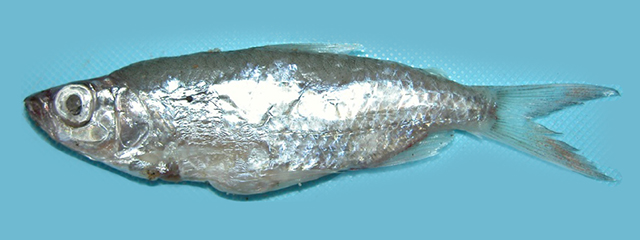| Alestidae (African tetras) |
| 25.4 cm TL (male/unsexed); max.weight: 200.0 g |
|
pelagic; freshwater; pH range: 6 - 7.80000019073486; dH range: 30, potamodromous |
| Africa: widely distributed in West Africa (Ref. 2880, 81279). In Lower Guinea present in Cross and Mémé rivers (Ref. 80279). Also in Chad basin (Ref. 367, 81279) and Nile River (Ref. 28714, 31439, 58460) up to Lake Albert (Ref. 4903, 42019). |
|
Anal spines: 0-0; Anal soft rays: 13-18. Diagnosis: multicuspid teeth set in two rows and not overlapping the jaws when the mouth is closed; teeth stout, not compressed; eyes with well-developed vertical adipose lids; slender body; head not flattened (Ref. 28714). Dorsal fin origin at about same level as pelvic fin insertion (Ref. 2880, 80290, 81279), about halfway between caudal fin and snout (Ref. 28714). Fronto-parietal fontanel absent in adults, sometimes pore-like in juveniles, disappearing with growth; sexual dimorphism affecting anal fin shape; 24-34 lateral line scales; 5.5 scales between lateral line and dorsal fin; 10-15 anal fin branched rays; 14-20 gill rakers on lower limb of first gill arch; 8 teeth in outer premaxillary row (Ref. 2880, 80290, 81279). Snout short, more than 3x head length; head length/snout length 3.6-4.3; 10-11.5 predorsal scales; flanks without lateral band; adults medium-sized (Ref. 80290).
Description: anal fin with 3 branched and 10-15 unbranched rays; jaws equal; premaxilla with two tooth rows, each comprimising 8 teeth; in larger individuals, two teeth of anterior row become dislodged, thus forming ‘third’ row (Ref. 2880, 80290, 81279).
Coloration: humeral spot; precaudal black spot, extending unto median rays of caudal fin to margin of caudal fork; back greenish, sides silvery and belly white; unpaired fins vermillion-red; pectorals and ventral colorless or, at most, light orange; part above eye red (Ref. 2880, 80290, 81279). |
| Inhabits rivers, lakes, irrigation canals and fringing vegetation; feeds on zooplankton, Caridina, insects, snails and vegetation (Ref. 28714). Dwarf populations are described in lake basins: Lake Turkana, B. n. nana Pellegrin, 1935 and Lake Chad, B. n. dageti Blache and Miton, 1960 (see Ref. 2880). |
|
Least Concern (LC); Date assessed: 16 April 2019 Ref. (130435)
|
| harmless |
Source and more info: www.fishbase.org. For personal, classroom, and other internal use only. Not for publication.
